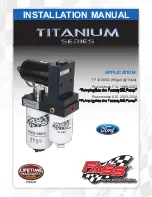
100-04-40
Noise, Vibration and Harshness
100-04-40
DIAGNOSIS AND TESTING (
CONTINUED
)
E859 EN
02/2001 2002 Bantam
• Worn, contaminated, or dry inboard front
wheel halfshaft joint or outboard front wheel
halfshaft joint.
Road Conditions
An experienced technician will always establish a
route that will be used for all NVH diagnosis road
tests. The road selected should be reasonably
smooth, level and free of undulations (unless a
particular condition needs to be identified). A
smooth asphalt road that allows driving over a
range of speeds is best. Gravel or bumpy roads
are unsuitable because of the additional road
noise produced. Once the route is established
and consistently used, the road noise variable is
eliminated from the test results.
If a customer complains of a noise or vibration on
a particular road and only on a particular road,
the source of the concern may be the road
surface. If possible, try to test the vehicle on the
same type of road.
Vehicle Preparation
Carry out a thorough visual inspection of the
vehicle before carrying out the road test. Note
anything, which is unusual. Do not repair or
adjust any condition until the road test is carried
out, unless the vehicle is inoperative or the
condition could pose a hazard to the technician.
After verifying the condition has been corrected,
make sure all components removed have been
installed.
Lift Test
After a road test, it is sometimes useful to do a
similar test on a vehicle lift.
1. Raise the vehicle on a vehicle lift.
2. Explore the speed range of interest using the
Road Test Quick Checks as previously
described.
3. Carryout a coast down in NEUTRAL. If the
vehicle is free of vibration when operating at
a steady indicated speed and behaves very
differently in DRIVE and COAST, a transaxle
concern is likely.
Note, however, that a test on the vehicle lift may
produce different vibrations and noises than a
road test because of the effect of the lift. It is not
unusual to find vibrations on the lift that were not
found in the road test. If the condition found on
the road can be duplicated on the lift, carrying out
experiments on the vehicle lift may save a great
deal of time.
NOTE:
Some concerns may be apparent only on
smooth asphalt roads.
When carrying out the high-speed shake
diagnosis or engine accessory vibration
diagnosis on a vehicle lift, observe the following
precautions:
WARNING: If only one drive wheel is
allowed to rotate, speed must be limited
to 55 km/h (35 mph) indicated on the
speedometer since actual wheel speed
will be twice that indicated on the
speedometer. Speed exceeding 55 km/h
(35 mph) or allowing the drive wheel to
hang unsupported could result in tyre
disintegration, differential failure and/or
constant velocity joint and halfshaft
failure, which could cause serious
personal injury and extensive vehicle
damage.
CAUTION: The suspension should not be
allowed to hang free. When the constant
velocity joint is run at a very high angle,
extra vibration as well as damage to
seals and joints can occur.
The front suspension lower arm should be
supported as far outboard as possible. To bring
the vehicle to its correct ride height, the full
weight of the vehicle should be supported in front
by floor jacks.
















































